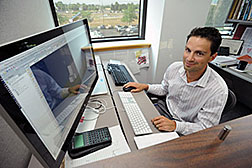- Number 442 |
- June 29, 2015
Idaho researcher improves seismic risk analysis

Justin Coleman.
An earthquake can strike at any time or place around the globe. The varying levels of seismic risk capture the attention of nuclear power plant designers and owners, who must take these data into account when evaluating plant safety.
Justin Coleman, a researcher at DOE's Idaho National Laboratory, plays a number of roles in an international effort to manage risk from external hazards at nuclear power plants. The effort relies heavily on scientific modeling. He oversees a collaboration of seismic researchers from laboratories, industry and academia, using their data to develop a standard methodology for the evaluation of seismic risk at a nuclear power plant site.
"A methodology is like a recipe," Coleman said. "Ideally, you follow the recipe correctly and you get a good result. My job is to create a ‘recipe' that details how to evaluate seismic risk."
Earthquakes don't occur with equal frequency everywhere on Earth. Some areas shoulder more risk for frequent and damaging earthquakes, while others rarely experience a tremor. To capitalize on the most advanced tools available, the modern nuclear industry turns with increasing frequency to modeling and simulation capabilities.
Coleman models the effect of seismic shock on nuclear power plant emergency systems, studies the transportation of used nuclear fuel, and authors language for nuclear power plant seismic design and analysis standards. These standards are used by industry when designing nuclear power plants.
Federal regulations mandate that nuclear power plants implement multiple layers of safety to prepare for even extremely unlikely occurrences. All U.S. plants are equipped with safety features capable of withstanding even higher degrees of seismic activity than the expected base risk for the plant site. A number of established methods exist to evaluate this base seismic risk and ensure the continuous preparedness of the nation's nuclear power plant fleet.
However, the method Coleman is developing stands out from its peers in that it considers different types of interactions between the soil and the structure of the nuclear power plant during a seismic event. These types of interactions may better predict the effect of larger earthquakes.
"Current methods for this type of evaluation rely on linear analyses, which correspond to low-level seismic shaking, or a smaller earthquake," he said. "To predict the effect of larger earthquakes, you need to use a method based on nonlinear analysis. It has fewer restrictions, so it gives a better representation of what would actually happen if there were a big earthquake."
Together, these methodologies would provide both government agencies and the nuclear energy industry with a comprehensive way to evaluate the risks faced by specific nuclear power plants. Plant owners can use the results to determine how to enhance the safety of their nuclear power plants and make more informed decisions.
"Following accurate methodologies when evaluating risk is important because it shows plant owners where to focus their attention," Coleman said. "If a plant is at very low risk from seismic activity, then the owner can focus on reducing risks that are more pressing. That ensures the best use of time and money and enhances the safety of the plant." – by Suzanne BakerSubmitted by DOE's Idaho National Laboratory
